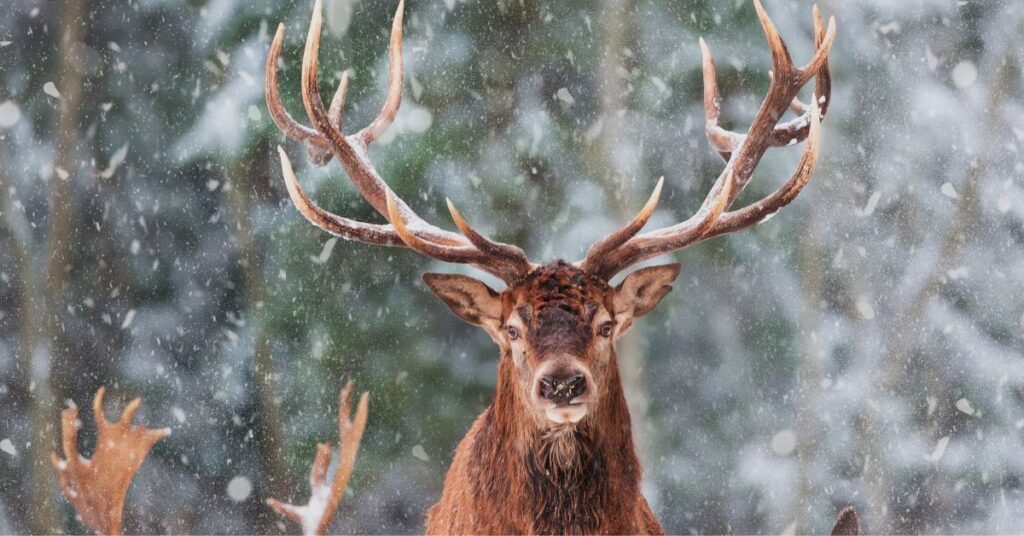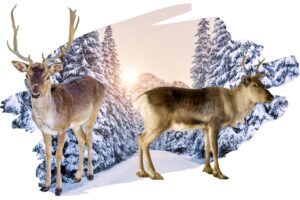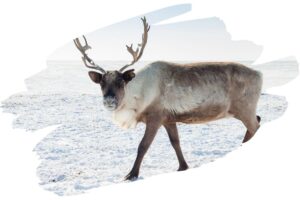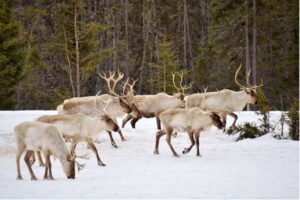
Table of Contents
Thick Fur Coats Keep Them Warm
Reindeer have clever ways to protect themselves in the harsh arctic where they live. Thick fur, big antlers, good senses, herd behavior and special traits help reindeer survive the cold.
The thick, woolly fur coat protects reindeer from the cold. The fur has hollow hairs filled with air. This traps heat near the skin. The thick underfur keeps them warm. The long guard hairs keep snow and water away. The fur is so warm that snow rarely melts on their backs. This winter coat lets reindeer handle temperatures as low as -50°F. Shedding and growing new coats each season also helps control their temperature.

Large Antlers For Fighting
Male reindeer grow big, complex antlers. They use these in the mating season to show their dominance. They defend themselves by clashing antlers when fighting over females.
The antlers can spread up to 51 inches wide and weigh over 22 pounds. Reindeer antlers are solid bone and very strong.
The size and strength of the antlers show if a male is fit and virile. So males with bigger antlers do better mating. For females, antlers may help defend food and protect young from predators.

Sharp Senses Detect Danger
Reindeer also rely on their sharp senses to avoid danger. They see extremely well and can spot food and predators in the snow.
Their big movable ears can pinpoint sounds quickly. Their sense of smell is great at finding predators from far away. By combining these senses, reindeer can quickly detect and escape threats. Herding also helps – with many eyes and ears on watch, spotting danger is easier.
Specialized Adaptations For Cold Climates
Reindeer have special traits to live in extreme cold climates. Their wide, crescent-shaped hooves work like snowshoes. This spreads their weight on snow.
Their big nostrils warm the frigid air before it gets to their lungs. Enzymes in their stomachs even let them digest lichens and mosses other animals cannot eat. This gives reindeer access to lots of food sources.
Herd Behavior Protects The Group
Certain behaviors also protect the herd. Migrating in large groups means less chance of being targeted. More reindeer make it harder for predators like wolves and bears to attack one reindeer. Males surround females and calves in the middle for more protection.
When threatened, reindeer can run 50 mph or swim fast across rivers and lakes to get away. Moving in big herds helps avoid attacks.

Reindeer Are Equipped To Survive
So how do reindeer protect themselves in the arctic tundra? With great adaptations, herd behaviors and sharp senses. Thick fur and fat layers fight the cold. Huge antlers allow males to compete to mate.
Excellent vision, hearing and smell help find dangers fast. Special hooves, nostrils and digestion let them live where few animals can. And migrating in big groups minimizes risks.
Reindeer truly have what it takes to survive and thrive in one of the harshest environments on earth. Their brilliant traits enable them to do more than just endure the frigid arctic – they prosper.
Reindeer FAQ
What are 2 ways that reindeer protect themselves?
Reindeer protect themselves using their antlers for fighting and their strong legs for running away from predators.
What helps a reindeer survive?
Their thick fur keeps them warm, while their hooves adapt to different terrains, aiding in travel and searching for food.
Do reindeer have no predators?
Reindeer do have predators, including wolves, bears, and eagles (preying on the young).
What body part does a reindeer use to fight?
Reindeer use their antlers to fight, especially during the mating season.
Why do reindeers lose their antlers?
Reindeer lose their antlers as part of an annual cycle, making room for new antler growth.
Is it true only female reindeer have antlers?
No, both male and female reindeer grow antlers, but males typically shed theirs in winter, while females keep theirs through the season.
Is Rudolph a male or female?
Rudolph, as traditionally depicted, is male, but some argue he could be female based on the fact that he has antlers in December.
Are all Santa’s reindeers female?
There is a popular theory that Santa’s reindeer are female since they all have antlers in December, but traditionally, they are depicted as male.
What is a reindeer’s lifespan?
Reindeer typically live around 15-20 years in the wild.
Who named Santa’s reindeer?
Santa’s reindeer were named by Clement Clarke Moore in his 1823 poem “A Visit from St. Nicholas,” more commonly known as “The Night Before Christmas.”
Is Rudolph a female reindeer?
While traditionally depicted as male, some argue Rudolph could be female since he/she has antlers in December.
Why did reindeer go extinct?
Reindeer have not gone extinct; they are still present in various regions of the world.
Does it hurt when antlers fall off?
No, the shedding of antlers is a natural process that does not cause pain to the reindeer.
Is there blood inside antlers?
While the antlers are growing, they are covered in a layer of skin called velvet, which supplies blood to the growing tissue. However, once fully grown, the blood supply stops, and the velvet is shed.
Do antlers grow back?
Yes, reindeer antlers grow back annually after they are shed.
